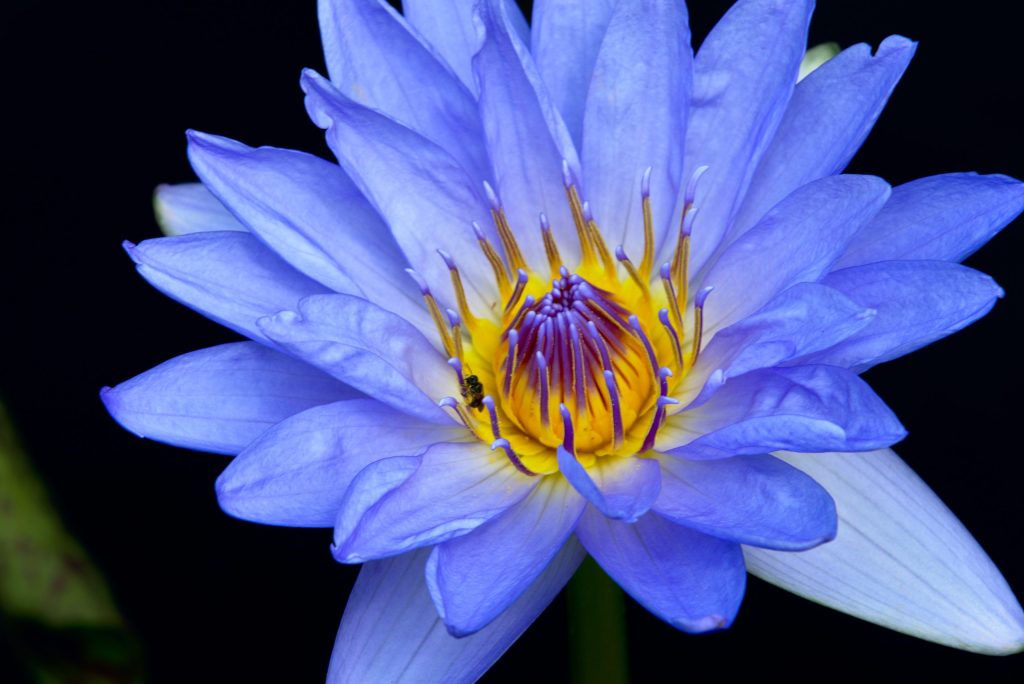Welcome to a world where calm meets adventure, where tranquility is fueled by a hint of the exotic. Join us on a journey into the unraveled mysteries of the Blue Lotus Flower Tea, a delightful, mind-altering drink consumed for its relaxing effects and psychoactive properties.
What Is Blue Lotus Flower Tea and Its Uses?

The Blue Lotus Flower, a beautiful aquatic plant, has been cherished for centuries for its unique properties and delicate flavor. Also known as the blue Egyptian lotus, it is renowned for its historical and cultural significance in ancient Egypt, where it was valued for its symbolism, psychoactive effects, and health benefits rooted in traditional practices.
Blue lotus flower tea is made from the dried petals of the Nymphaea caerulea plant and is often used in herbal medicine for its relaxing and mildly sedative effects. Blue lotus has been used in various herbal remedies throughout history for its calming and therapeutic effects.
Common forms of blue lotus consumption include teas, tinctures, and smoking or vaping.
Photo by Say Cheeze Studios on Unsplash
Understanding the Nymphaea Caerulea
The Blue Lotus Flower, scientifically named Nymphaea Caerulea and also known as the blue lily, blue water lily, or Egyptian Lotus, is a type of water lily native to Egypt. The blue lotus is considered an endangered plant due to habitat loss and overharvesting. This beautiful flowering plant has been used in ancient rituals and medicinally for centuries due to its calming and psychedelic effects. It is also renowned as a spiritual flower, revered in ancient rituals and ceremonies.
The Medicinal and Aromatherapeutic Uses of Blue Lotus
The Blue Lotus is more than just a pretty flower, it has found its place in herbal medicine for its rich compounds like nuciferine and notable medicinal properties. Many people use Blue Lotus flower recreationally steeped in tea, for its soothing aroma and its calming properties. The flower petals are distinctly known for their stress and anxiety reliever abilities when consumed.
Traditionally, Blue Lotus has also been used to support mental health, helping to alleviate symptoms of anxiety and depression. In traditional medicine, Blue Lotus has been used to address heart palpitations and other heart-related issues.
Blue Lotus in Herbal Tea Formation
Perhaps the most common uses of Blue Lotus are in the formation of herbal tea made from the blue lily flower, which is valued for its soothing effects.
This tea may be an effective sleep aid, providing relaxation. Blue lotus tea may also induce euphoria due to its psychoactive alkaloids.
It is traditionally used to enhance lucid dreams.
The History and Cultural Significance of Blue Lotus
The blue lotus flower, also known as the sacred blue lily, holds a legendary place in the tapestry of ancient times. Revered by the ancient Egyptians, the blue lotus was much more than a beautiful aquatic bloom—it was a symbol of rebirth, regeneration, and spiritual enlightenment. Often depicted in ancient Egyptian art and hieroglyphics, the blue lotus flower was closely linked to the sun god Ra, representing the sun’s daily journey and the promise of new beginnings. Its image adorned temples, tombs, and sacred texts, reflecting its deep cultural importance.
Beyond its visual symbolism, the blue lotus flower was cherished in traditional medicine for its calming and restorative health benefits. Ancient Egyptians believed that the blue lily could soothe the mind, relieve anxiety, and promote a sense of tranquility. Used in rituals and ceremonies, the sacred flower was thought to bridge the gap between the earthly and the divine, helping individuals connect with higher states of consciousness. Today, the blue lotus continues to be celebrated as a sacred flower in various cultures, valued for its spiritual and therapeutic properties.
Sacred Blue Lily Properties and Significance
The sacred blue lily, or blue water lily, is a truly fascinating plant with a wealth of unique properties and enduring significance. Native to the tranquil waters of the Nile River, this aquatic perennial plant is instantly recognizable by its vibrant blue petals and radiant golden center. The blue lotus flower is not only admired for its beauty but also for its remarkable psychoactive properties, which have been harnessed for centuries in both traditional medicine and spiritual rituals.
Rich in bioactive compounds such as apomorphine and nuciferine, the blue lotus flower offers a range of health benefits. These natural compounds are known to promote relaxation, reduce anxiety, and support restful sleep, making blue lotus flower tea a popular choice for those seeking a gentle, natural remedy. The flower has also been used to address issues like insomnia, erectile dysfunction, and menstrual cycle irregularities, highlighting its versatility as a medicinal herb.
In addition to brewing blue lotus flower tea or lotus tea, some choose to experience the effects of blue lotus by consuming blue lotus flower in other forms, such as smoking dried blue lotus flowers with rolling papers. However, it’s important to approach these methods with care, as high doses can intensify the psychoactive nature of the plant. As with any herbal remedy, consulting a healthcare professional before using blue lotus flower for medicinal purposes is always recommended.
The sacred blue lily remains a symbol of spiritual growth and connection, cherished in rituals and ceremonies across cultures. Whether enjoyed as a soothing flower tea or revered as a sacred flower, the blue lotus continues to captivate and inspire, bridging the worlds of ancient tradition and modern wellness.
How to Make Blue Lotus Flower Tea?
A Step-by-step Guide to Prepare The Tea
Making Blue Lotus Tea involves steeping the dried blue lotus flowers in hot water. A simple yet delicate procedure that enables you to make tea with Blue Lotus at home, and immerse yourself in a mind-altering journey towards relaxation and tranquility.
Alternatively, you can use blue lotus tinctures by adding a few drops to water as another way to enjoy the tea.
Best Practices in Using Dried Blue Lotus Flowers
When using dried Blue Lotus flowers, it is important to store them in a cool, dry place to preserve their psychoactive effects. Ensure to use them sparingly in your tea preparation considering their potent effects.
How to Use a Blue Lotus Tea bag
For those who prefer tea bags, Blue Lotus Tea bags are made from the blue lily flower, retaining all the essential compounds for a calming experience. Simply steep the Blue Lotus Tea bag in hot water, allow it to infuse for a few minutes, and your tea is ready to be savored.
The Psychoactive and Aphrodisiac Effects of Blue Lotus
Examining the Compound Nuciferine
Nuciferine, a major compound in Blue Lotus, is believed to contribute to its psychoactive effects. This compound interacts with the brain’s dopamine receptors to induce a sensation of calmness and subtle euphoria.
Blue Lotus and Lucid Dreaming
There have been reports suggesting that consuming Blue Lotus tea before bed may enhance lucid dreaming. While scientific research is yet to fully back this claim, many individuals swear by its effectiveness, endorsing an enchanting sleep adventure.
Aphrodisiac Effects of the Blue Lotus: Myth or Reality?
Blue Lotus tea is often associated with aphrodisiac effects. While anecdotal evidence supports this claim, scientific validation is still needed. However, the psychoactive effects of this tea may well influence mood and intimacy.
Potential Side Effects of Blue Lotus Flower Tea
Understanding the Risks of Consuming Blue Lotus
While Blue Lotus tea provides a calming experience, there could be potential side effects. It’s always advisable to consume in moderation and under supervision if you are new to this mind-altering drink.
Common Side Effects of Tea Drinking
Typical side effects of drinking tea include sleep disturbances due to caffeine or vivid dreams because of certain botanicals. For Blue Lotus tea, some individuals have reported experiencing a mild psychoactive state.
Tips to Avoid Potential Side Effects
To minimize potential side effects, it is advised to start with a mild brew of Blue Lotus tea, gradually increasing concentration as your body adjusts to its effects.
Where to Buy Blue Lotus Flower For Tea Making?
Buying Dried Blue Lotus Flowers for Tea Making
Dried Blue Lotus flowers can be bought from reputable online retailers, ensuring they are suitable for human consumption and not just for decorative purposes.
Where to Get Quality Blue Lotus Flower Tea Bag
High-quality Blue Lotus tea bags can also be found online and in stores. Look for fair-trade and organic options when possible to ensure a high-quality, sustainable product.
Import Customs to be Aware of When Buying Blue Lotus
When buying Blue Lotus, make sure to familiarize yourself with any import regulations pertaining to your country to avoid any possible issues. Always go for reputable vendors to ensure you get the finest quality of Blue Lotus for a soothing, calm, and profound tea experience.
###
Q: How is the aroma of Blue Lotus Flower Tea typically described?
A: The aroma of Blue Lotus Flower Tea is often described as mildly sweet and floral. The scent is similar to other flower teas but has a unique depth that makes it stand out.
### ###
Q: What are the effects of Blue Lotus Tea?
A: The effects of Blue Lotus Tea are diverse. It is known to have mild psychoactive effects and may induce lucid dreaming. It has been associated with psychedelic effects, although it’s gentle and not overwhelming. Always remember that each individual’s response may vary.
Some users experience different effects when smoking blue lotus, which can be done using a smoking device such as a pipe or rolling papers.
Blue lotus is also traditionally used as an ingredient in massage oil for its relaxing properties.
Q: How can the Blue Lotus flower induce lucid dreaming?
A: Blue Lotus Flower is associated with psychedelic effects and lucid dreaming. This is due to the presence of compounds like nuciferine and aporphine in the flower. Although research is still ongoing, many users report increased vividness and improved recall of their dreams.
### ###
Q: What are blue lotus tea dried flowers?
A: Blue lotus tea dried flowers are the flowers of the sacred blue lotus that have been dried and processed to be used in tea. These flowers are typically steeped in hot water to extract the beneficial compounds present in the flower.
### ###
Q: How is the blue lotus tea made?
A: Blue lotus tea is made by adding a few teaspoons of dried blue lotus flowers to a cup of hot water. Allow it to steep for 5-10 minutes and then strain the liquid. This method is similar to making other herbal teas.
### ###
Q: Is the blue lotus flower used in ancient Egypt?
A: Yes, the blue lotus flower is used in ancient Egypt. It was an important part of their culture and belief system. The flowers were used in religious ceremonies and were also often depicted in ancient Egyptian art.
### ###
Q: What are the health benefits of drinking blue lotus flower tea?
A: The blue lotus flower may harbor various health benefits although research is still in the preliminary stage. As a tea, it is reputed to offer relaxation, improved sleep, and calming effects. The tea was used historically for its soothing properties.
### ###
Q: What does the blue lotus extract contain?
A: The blue lotus extract contains several beneficial compounds, including the two primary psychoactive components – nuciferine and aporphine.
### ###
Q: Is consuming blue lotus flower tea regulated by food and drug administration?
A: Currently, the food and drug administration (FDA) has not evaluated the safety and efficacy of consuming blue lotus flower. As with any supplement or herbal product, you should consult with a healthcare professional before use.
### ###
Q: How does the taste of blue lotus tea compare to other teas?
A: The taste of blue lotus tea is unique. It is subtly sweet with floral notes. While it is difficult to compare to other teas directly, some find its taste similar to a cross between chamomile and lavender.
###

